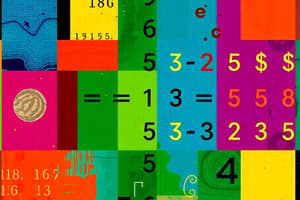Podcast
Questions and Answers
What is the main advantage of using a Feistel cipher structure?
What is the main advantage of using a Feistel cipher structure?
- It provides stronger encryption by using more rounds.
- It reduces the size of the code or circuitry required to implement the cipher. (correct)
- It allows for faster encryption and decryption operations.
- It increases the complexity of the key schedule.
What is the purpose of the concept of 'Diffusion' in the Feistel cipher?
What is the purpose of the concept of 'Diffusion' in the Feistel cipher?
- To make the cipher more resistant to brute-force attacks.
- To ensure that a single bit change in the plaintext results in a completely different ciphertext. (correct)
- To increase the number of rounds in the cipher.
- To hide the relationship between the ciphertext and the encryption key.
What is the purpose of the concept of 'Confusion' in the Feistel cipher?
What is the purpose of the concept of 'Confusion' in the Feistel cipher?
- To hide the relationship between the ciphertext and the plaintext.
- To increase the number of rounds in the cipher.
- To ensure that a single bit change in the key results in a completely different ciphertext. (correct)
- To make the cipher more resistant to chosen-plaintext attacks.
What is the purpose of creating 16 subkeys, each 48-bits long, in the DES algorithm?
What is the purpose of creating 16 subkeys, each 48-bits long, in the DES algorithm?
Which of the following is NOT a key property of the Feistel cipher structure?
Which of the following is NOT a key property of the Feistel cipher structure?
What is the purpose of the PC-1 permutation table?
What is the purpose of the PC-1 permutation table?
What is the value of $C_4$ in the solution?
What is the value of $C_4$ in the solution?
What is the value of $D_4$ in the solution?
What is the value of $D_4$ in the solution?
What is the final value of the 56-bit key $K_4$?
What is the final value of the 56-bit key $K_4$?
What is the purpose of the circular left shift operation on the key in the DES algorithm?
What is the purpose of the circular left shift operation on the key in the DES algorithm?
Flashcards are hidden until you start studying
Study Notes
Feistel Cipher
- A symmetric structure used in constructing block ciphers, also known as a Feistel network.
- Offers the advantage of similar encryption and decryption operations, requiring only a reversal of the key schedule.
- Reduces the size of the code or circuitry required to implement the cipher by nearly half.
Feistel's Proposal
- Utilizes a cipher that alternates between substitutions and permutations.
- Implements diffusion and confusion to hide relationships between the ciphertext and plaintext, and the ciphertext and encryption key.
Diffusion
- Hides the relationship between the ciphertext and plaintext by making each symbol in the ciphertext dependent on some or all symbols in the plaintext.
- A single change in the plaintext will result in multiple changes in the ciphertext.
Confusion
- Hides the relationship between the ciphertext and encryption key by making most or all bits in the ciphertext change when a single bit in the key is changed.
Data Encryption Standard (DES)
- A block cipher that uses the Feistel structure.
How DES Works
- The 64-bit key is permuted according to the PC-1 table to create 16 subkeys, each 48-bits long.
- The subkeys are used in the encryption and decryption process.
Example: Key Generation
- A hexadecimal key K = 133457799BBCDFF1 is converted to a binary key.
- The binary key is permuted according to the PC-1 table to create 16 subkeys.
- Each subkey is 48-bits long.
Studying That Suits You
Use AI to generate personalized quizzes and flashcards to suit your learning preferences.




